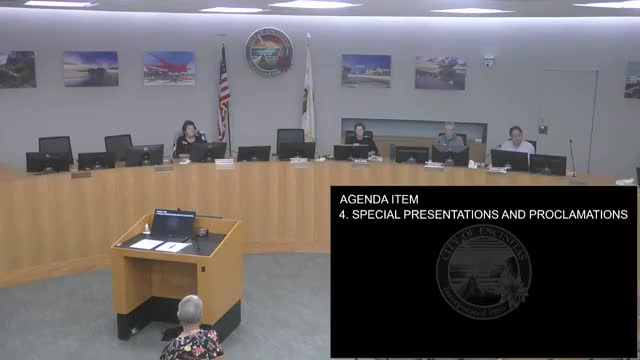County specialist outlines early signs of dementia and local resources at Encinitas meeting
October 21, 2025 | Encinitas, San Diego County, California
This article was created by AI summarizing key points discussed. AI makes mistakes, so for full details and context, please refer to the video of the full meeting. Please report any errors so we can fix them. Report an error »

Jonathan Tagg, outreach and education specialist with Aging and Independent Services (AIS) at the County of San Diego Health and Human Services Agency, told the Encinitas Senior Citizen Commission on Oct. 21 that dementia is a disease of the brain, not a normal part of aging, and outlined warning signs, next steps and county supports for people living with dementia and their caregivers.
Tagg said San Diego County currently has an estimated 50,000 residents living with dementia and that number is expected to grow as the population ages. "Dementia is not part of normal aging," he told the commission, and advised that families seek medical evaluation when memory or other changes begin to disrupt daily life.
He walked commissioners through commonly observed early signs — including persistent memory loss, difficulty completing familiar tasks, confusion about time or place, trouble with words, misplacing items in inappropriate locations, decreased judgment, withdrawal from social activities and personality or mood changes — and emphasized that not every person shows the same pattern. "If you met one person with dementia, you've met one person with dementia," Tagg said, noting the disease progresses differently in each case.
For families and caregivers, Tagg recommended starting with a primary care physician and, when appropriate, referral to specialists such as neurologists or geriatric counselors. He urged preparation of advance health care directives and the use of a "vial of life" form that lists medications and emergency contacts. Tagg also described five general steps to support brain health — healthy eating, physical activity, social connection, mentally challenging activities and control of chronic conditions such as high blood pressure — and encouraged person-centered planning so people living with dementia remain involved in decisions about their care.
Tagg summarized county programs and resources available to people living with dementia, including the long-running Alzheimer's Project, a clinical roundtable of clinicians and a caregiver roundtable; in‑home supportive services and the IHSS Public Authority program that can compensate family caregivers in certain cases; Adult Protective Services and a specialized Alzheimer’s Response Team for investigations involving elder abuse; and partnerships with the Southern Caregiver Resource Center and local organizations such as the Alzheimer's Association San Diego & Imperial Chapter and Glenner centers. He also described two sheriff’s office programs: the Take Me Home registry for missing persons with cognitive impairment and the Blue Envelope program, which signals to first responders that a person has communication differences and may need different contact approaches.
Tagg closed by pointing commissioners to AIS's call center as a single entry point for services and to county handouts and toolkits distributed at the meeting. Commissioners responded with thanks and several said they would share materials with family members and community groups.
Tagg said San Diego County currently has an estimated 50,000 residents living with dementia and that number is expected to grow as the population ages. "Dementia is not part of normal aging," he told the commission, and advised that families seek medical evaluation when memory or other changes begin to disrupt daily life.
He walked commissioners through commonly observed early signs — including persistent memory loss, difficulty completing familiar tasks, confusion about time or place, trouble with words, misplacing items in inappropriate locations, decreased judgment, withdrawal from social activities and personality or mood changes — and emphasized that not every person shows the same pattern. "If you met one person with dementia, you've met one person with dementia," Tagg said, noting the disease progresses differently in each case.
For families and caregivers, Tagg recommended starting with a primary care physician and, when appropriate, referral to specialists such as neurologists or geriatric counselors. He urged preparation of advance health care directives and the use of a "vial of life" form that lists medications and emergency contacts. Tagg also described five general steps to support brain health — healthy eating, physical activity, social connection, mentally challenging activities and control of chronic conditions such as high blood pressure — and encouraged person-centered planning so people living with dementia remain involved in decisions about their care.
Tagg summarized county programs and resources available to people living with dementia, including the long-running Alzheimer's Project, a clinical roundtable of clinicians and a caregiver roundtable; in‑home supportive services and the IHSS Public Authority program that can compensate family caregivers in certain cases; Adult Protective Services and a specialized Alzheimer’s Response Team for investigations involving elder abuse; and partnerships with the Southern Caregiver Resource Center and local organizations such as the Alzheimer's Association San Diego & Imperial Chapter and Glenner centers. He also described two sheriff’s office programs: the Take Me Home registry for missing persons with cognitive impairment and the Blue Envelope program, which signals to first responders that a person has communication differences and may need different contact approaches.
Tagg closed by pointing commissioners to AIS's call center as a single entry point for services and to county handouts and toolkits distributed at the meeting. Commissioners responded with thanks and several said they would share materials with family members and community groups.
View full meeting
This article is based on a recent meeting—watch the full video and explore the complete transcript for deeper insights into the discussion.
View full meeting
